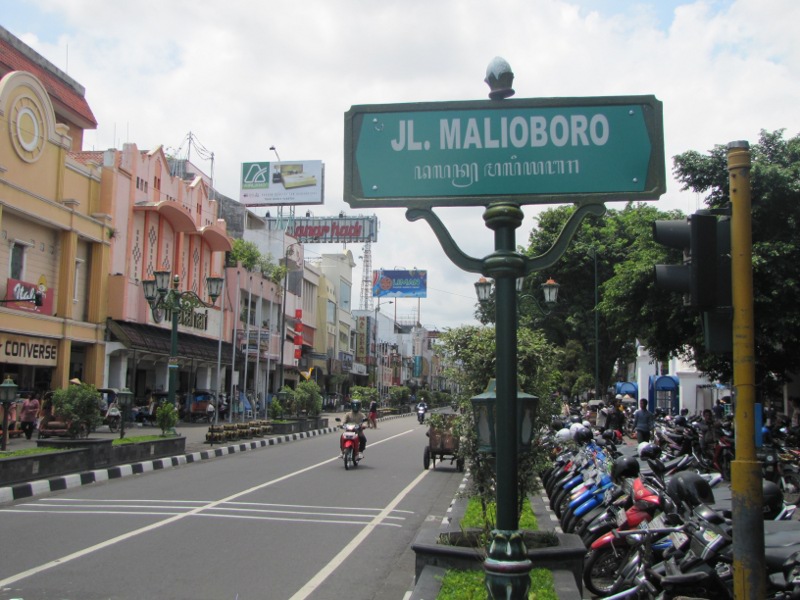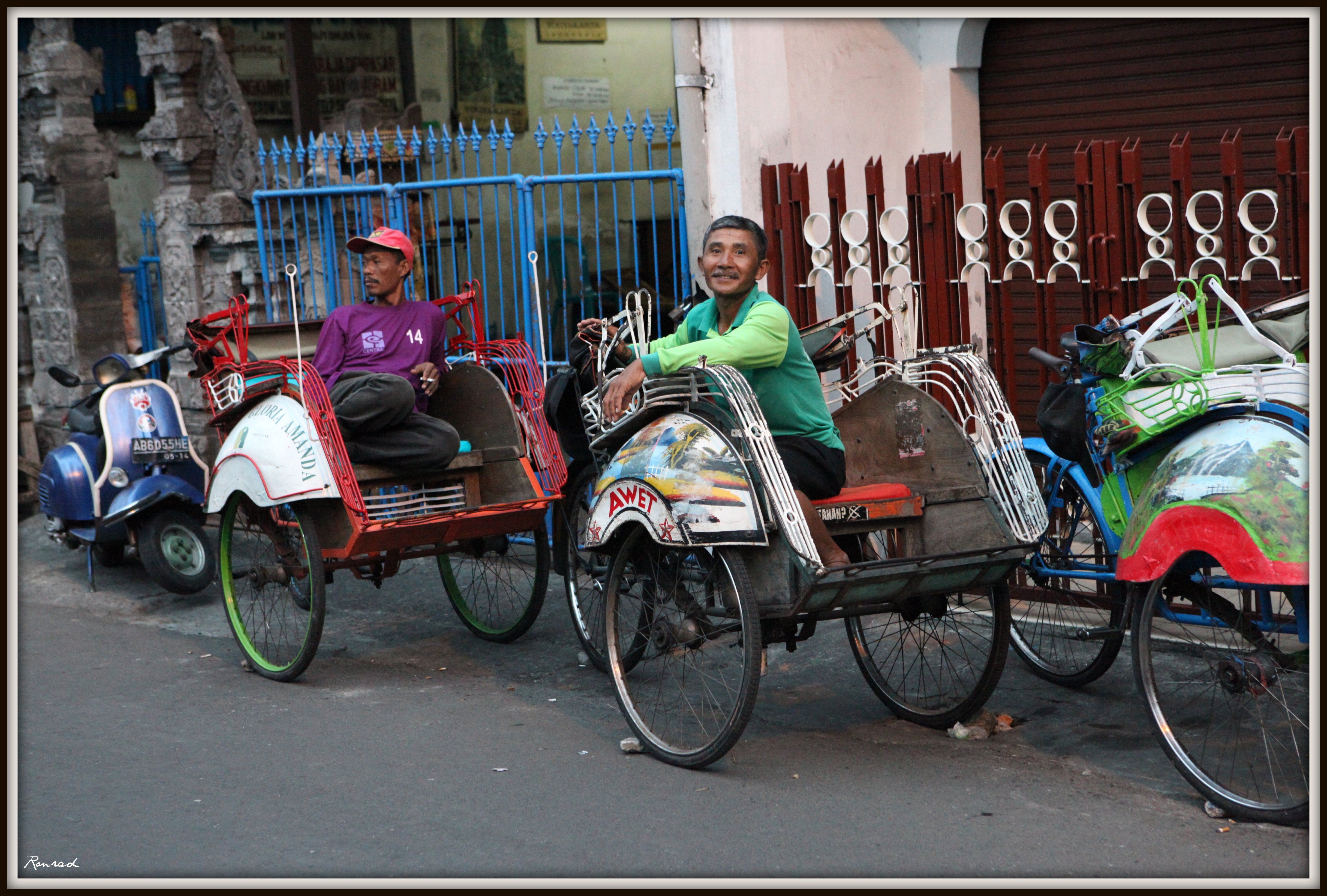The City of Yogyakarta

After so many long, arduous Sumatran bus journeys I was excited to take the train. My expectations weren't high; I just assumed it would be better than a 20 year old broken down bus plodding though never-ending holiday traffic. And my first Indonesian train experience wasn't just better than the bus; it was great: an air-con compartment, a smooth ride, and large, comfy chairs. It definitely beat out Thai trains, and wasn't far off my Eurorail train experience.
 |
| To my surprise the train was comfortable, clean, and fast! |
Whereas Jakarta is the political and economic capital of Java, Yogyakarta is its cultural capital. Yogyakarta, or Yogya (pronounced "jogja") for short, was the capital of a powerful Javanese sultanate and even the capital of Indonesia for 3 years during the revolution against Dutch colonial rule. Once full independence was recognized Jakarta became the permanent seat of government.
Yogya is the most important tourist destination on the island Java, and the second most popular destination for international visitors after Bali. Most use the city as a base to explore the nearby Borobudur and Prambanan temples. But the city of Yogya itself also has much to offer: the sultan's palace grounds, cultural museums, ancient city bath houses, art galleries, and shops selling traditional clothing and jewelry.
 |
| Yogya, in central Java |
 |
| part of Borobudur temple |
My train arrived bright and early at 4 am; well actually it was too early to be bright, the sun hadn't yet come up! At the train station I got tea with the Indonesian who had been sitting next to me on the trip from Jakarta. He had all of one day in Yogya - he'd gotten off work, gone to the train station and taken the overnight train. He would see Borobudur that morning and get back to Jakarta late the same night, then go back to work the following day! All he had with him was a small briefcase and his work clothes.
My seat neighbor from the train offered to help find me a guesthouse, which was a nice gesture, although he had never been to Yogya either. He said he knew of a few guesthouses, but we had to ask five people on the street for directions. After getting five different answers, we finally found it after 30 minutes of searching (luckily the train station is right in town). And once we did the cheapest rooms at the guesthouse were sold out. I wasn't willing to pay 20 dollars for a room, even though it did look classy. Eventually I had to courteously suggest that the guy go on and arrange his trip to Borobudur while I found a place on my own. He meant well but wasn't very helpful!
Using a map in my guidebook it didn't take me long to find the section of town - even back on the way to the train station where we had started - with lots of budget guesthouses. I found a room with AC and private bathroom for less than 10 dollars. And the best part was I had a hot and cold water shower head! That was much more of a deal breaker for me than the AC!
After unloading my things and showering it was still early in the morning. I'm usually not up early enough to realize just how much you can get done before 8 am! My guidebook listed the price of a tour to Borobudur as low as 80,000 Rupiah (8 dollars), but most shops weren't yet open. I found out you have to book the early morning tours a day in advance so the company can arrange transport. No big deal; I'd put Borobudur off until the next day and see central Yogya. Besides, it would be better to see the temples after a solid night sleep.
Despite lack of sleep on the overnight train ride I felt fine and managed a full day of sightseeing around Yogya. For me, especially when I am getting my bearings, sightseeing typically involves exploring by foot. Walking around the city all day may not sound like fun to some, but for me it's the best way to get a feel for a new place.
 |
| Becak, cycle rickshaws, still operate in Yogya. A generation ago they were a common mode of transport but have largely been replaced by motos, buses, and taxis. Today they exist mostly as a tourist attraction; I prefer to do my sightseeing by foot! |
Following breakfast I visited the Sono-Budoyo Museum, which has a fine collection of local art, including puppets, decorative masks, batik, and Hindu carvings. Before the local leader converted to Islam and took the title of sultan, many inhabitants were Hindu. Each individual or group visiting the museum gets a free tour guide. They wouldn't even accept tips! My guide was actually Catholic, although like the rest of Java, the prominent religion in Yogya is Islam.
Next I walked to the nearby Kraton, the sultan's palace. There is still a living sultan who calls the palace home. Although most of the sultan's power has been transferred to the elected government, he is technically a reigning monarch who wields power over the hearts and minds of his subjects. Reverence to the sultan is a matter of locals' pride in their history and culture; even the Catholic tour guide spoke highly of him, as if he was his king. Many buildings on the palace grounds date to the 18th and 19th centuries. You can't see the whole grounds, but even the area open to the public is huge (although not well displayed). While I was visiting palace musicians performed the gamelan, a traditional Javanese and Balinese ensemble.
| One of the royal halls inside the sultan's Kraton |
 |
| Gamelan: a large set of different instruments tuned to be played together; like an Indonesian orchestra |
That afternoon I checked out the ruins of royal bath houses (largely destroyed in an earthquake), a local market, and walked around several less touristy neighborhoods. While on my self-guided tour I discovered Lotek, a delicious and healthy local food with tofu, spinach, bean sprouts, and rice cubes mixed together in a spicy peanut sauce.
 |
| Lotek - tastes better than it looks! |
I also met a few local kids who, like many Indonesians, were curious and friendly. They invited me to sit down outside of their house, and then took me on a walk around the neighborhood. We communicated with a mix of English, Indonesian, and mime, which worked surprisingly well. The three girls seemed to take a liking to me and were clearly upset when several boys they knew vied for my attention. Back at a house (whose it was I didn't know) I met their parents, who spoke a bit of English. The girls said something about going on a walk - I couldn't tell exactly what they meant - so I thought, what the heck let's go. Next thing I knew I was walking with them to the mall.
So there I was with three Indonesian girls, between 8 and 10 years old, at the mall in Yogya. We (and by we I mean they, as I tentatively followed) checked out the clothing section and I got a few puzzled looks from the employees. They then led me to the top floor, which was similar to a Chuck-e-Cheese's back home, with games that award tickets, and prizes at the counter. For 3 bucks I bought a roll of game coins, enough so the girls could play a handful of games each. Their favorite was probably dance dance revolution.
 |
| I didn't know these things still existed! |
Once their coins were used up they had enough tickets to get a couple small candies each. They had combined all their tickets and chose the prizes collectively without any hesitation, and I never sensed any disappointment because they didn't have enough for a bigger prize. The kids had a home and food to eat, but I could tell they didn't do this sort of thing often. I can only imagine the fighting that would ensue with kids back in the US - "No I want that one!" "But I won more tickets than you!" "Mom we need more coins!" (would I be the mom in this example?). Once they chose their prizes it was time to go home. They parents had said to be back by 5pm, but that's about all the instructions they gave - trustworthy parents - or maybe they were just happy to have a babysitter!
When I returned the parents offered me a snack, I stayed to chat for a few minutes (although their English was limited), and we took pictures. I said my goodbyes - the girls were sad to see me go - and I headed back toward my guesthouse, a normal tourist again. Overall that was both a strange experience and a great memory. It definitely wouldn't happen in the US. I can only imagine the kind of trouble if a random stranger stopped to talk to a group of kids and took three of the girls to the mall!
 |
| A typical neighborhood in Yogya; I wish my camera worked! |
 |
| Jalan Maliboro, the heart of the tourist area |
That evening I checked out Jalan Maliboro, the main drag in the tourist area. Art and souvenir shops line both sides of the streets, which were packed with foreign and domestic tourists. Many shops sell batik, a traditional decorative cloth, and the touts have a reputation for being pushy. The crowds made it easy to avoid them though. Once I got back to the guesthouse fatigue from little sleep and a full day on my feet set in. I dozed off by 10 pm, hoping to sleep well and get an early start to Borobudur the following morning.


Comments